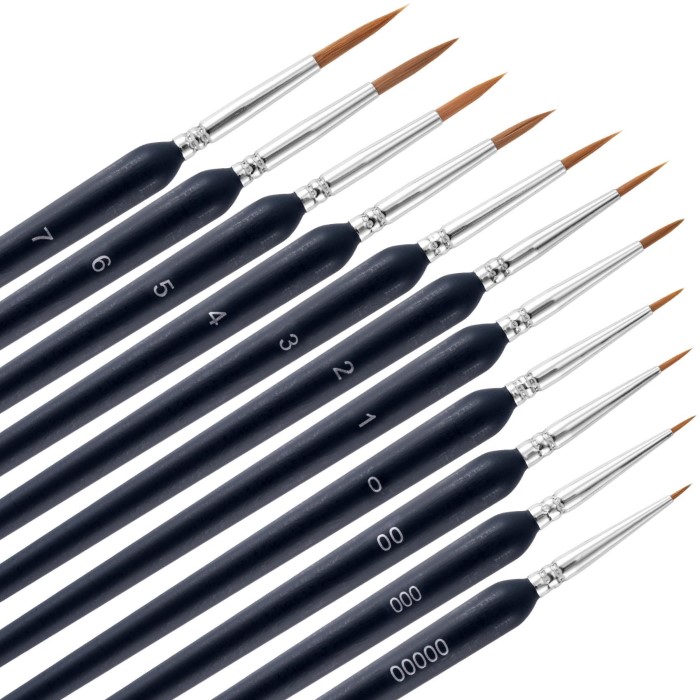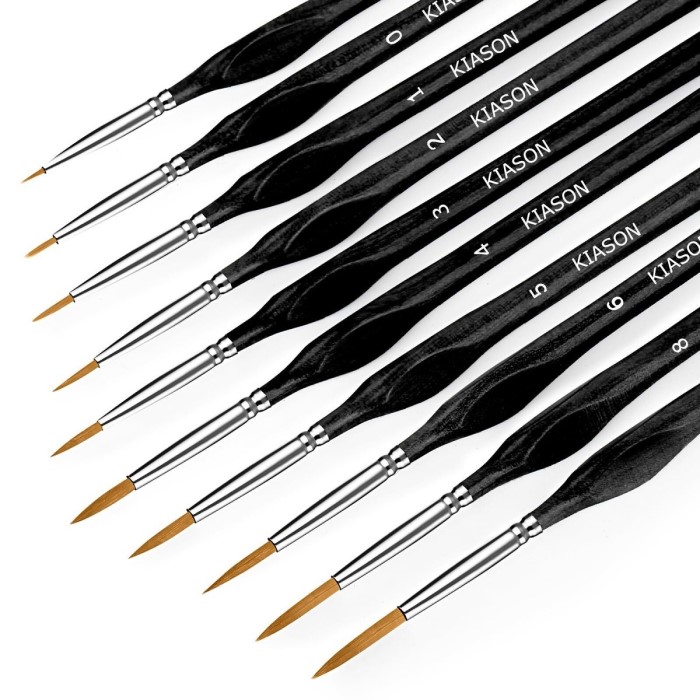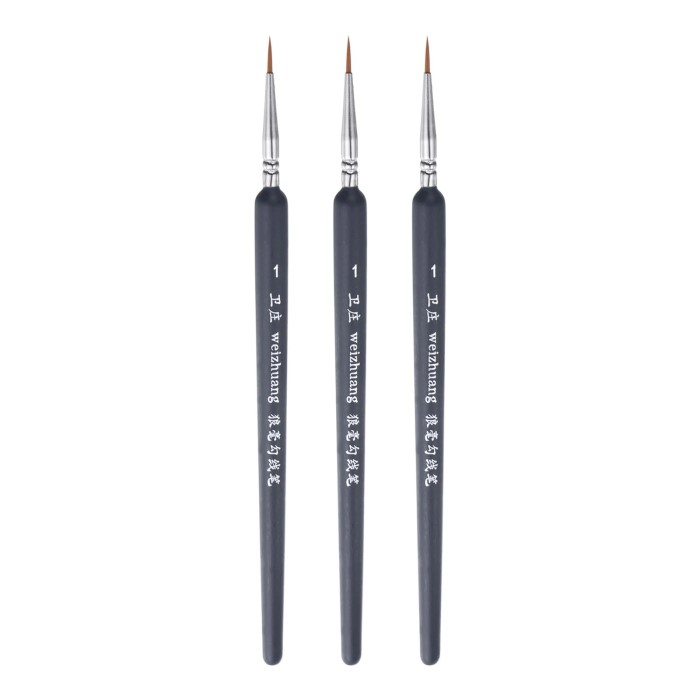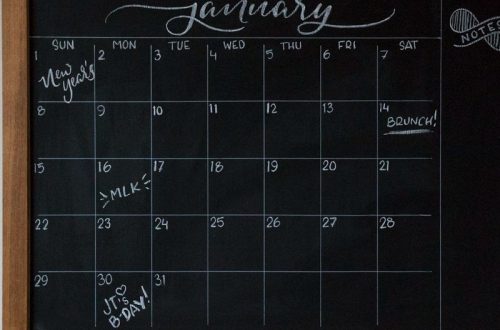Introduction
Miniature painting requires precision and detail work. Choosing the right brushes can improve results greatly. Understanding miniature painting brushes features and types is essential for mastering miniature painting techniques.
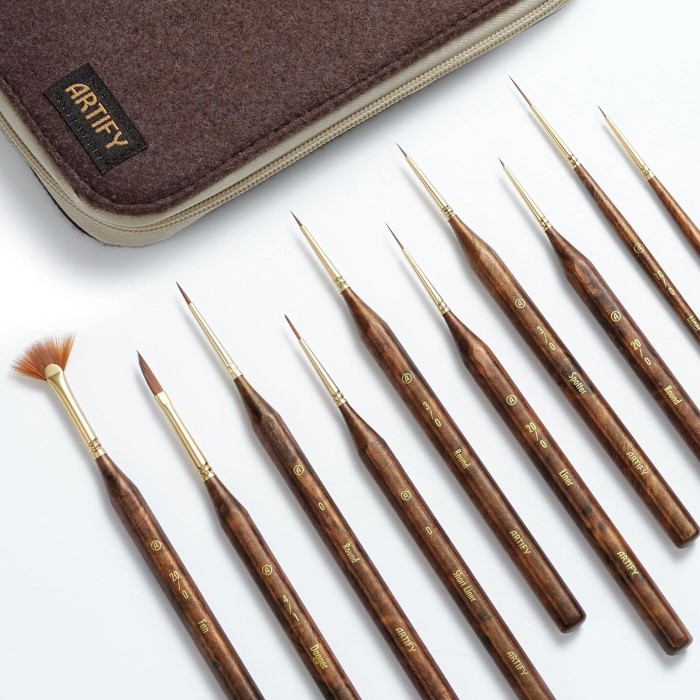
Why Selecting the Right Brushes Matters
Brushes impact paint application and overall artistic quality. The right brush ensures smooth control and maximum precision. Selecting proper brushes reduces frustration and enhances efficiency during miniature painting projects.
Common Types of Brushes Used in Miniature Painting
- Round Brushes: Versatile for general painting and fine details.
- Flat Brushes: Ideal for covering larger areas and layering paint.
- Detailing Brushes: Designed for intricate patterns and tiny areas.
- Dry Brushes: Useful for texturing and highlighting raised surfaces.
- Wash Brushes: Perfect for applying large washes to miniatures.
Each brush serves a unique purpose. Knowing their uses helps in selecting the correct tools for miniature painting.
Essential Features
Choosing miniature painting brushes requires attention to specific features. These features impact performance and painting results. Below are essential aspects to consider when selecting the perfect brushes.
Brush Tip Shapes and Their Uses
Brush tip shapes determine the strokes and effects a brush can create. Here’s a breakdown of common shapes:
- Round Tips: Ideal for detailed work, including curves and precise touch-ups. They are the most versatile.
- Flat Tips: Best for covering broad areas and applying base coats. They help with even layering.
- Pointed Round Tips: Useful for fine detail and precise lines. They are perfect for small but focused work.
- Angle Tips: Great for tight corners and angled strokes. They offer controlled edge painting.
- Fan Tips: Suitable for blending and soft textures. They add unique effects to your miniature designs.
Understanding the uses of these shapes simplifies your brush selection process.
Hair Types: Synthetic vs Natural Bristles
Brush bristle material affects precision, paint control, and longevity. Let’s explore the options:
- Synthetic Bristles:
- Made from man-made fibers like nylon or polyester.
- They are more affordable and durable.
- Perfect for beginners and heavy-duty use.
- Natural Bristles:
- Made from animal hair, like sable or kolinsky.
- Known for superior paint retention and fine tips.
- They are pricier but favored by professionals for detail work.
Choosing between synthetic and natural bristles depends on your budget and the desired painting quality.
Brush Sizes and How They Impact Precision
Brush size impacts how detailed or broad your strokes will be. Sizes are labeled by numbers:
- Smaller Sizes (e.g., 0, 00, 000):
- Perfect for tiny details, eyes, or intricate patterns.
- They provide high control over delicate work.
- Medium Sizes (e.g., 1, 2, 3):
- Suitable for general detail and base layer painting.
- Good for moderate-sized areas.
- Larger Sizes (e.g., 4, 5, 6):
- Designed for base coats and larger surfaces.
- Help in speeding up broader applications.
Selecting the right size ensures greater control and accuracy for different painting stages.
Specialized Brushes for Detailed Work
Miniature painting often demands precise tools for intricate details and unique effects. Specialized brushes play a significant role in achieving these results. Two key types of specialized brushes are detailing brushes and dry brushes, each used for distinct purposes in miniature painting.
Detailing Brushes for Fine Lines and Intricate Areas
Detailing brushes are essential for painting tiny features and adding precision to your work. Here’s why they matter:
- Small Tips for Maximum Control: These brushes have fine, pointed tips for tight spaces and sharp lines.
- Perfect for Features: Ideal for painting eyes, facial features, and intricate patterns on miniatures.
- Enhanced Accuracy: They minimize mistakes, ensuring clean and focused strokes.
Common sizes for detailing brushes include 0, 00, and 000. Using these helps achieve a professional finish in your miniatures.
Dry Brushes for Texturing and Layers
Dry brushes are designed for techniques that highlight raised surfaces and textures. Here’s how they are used:
Texturing Effects
- Creating Realistic Weathering: Texturing effects are essential for simulating realistic weathering on miniatures. By applying textures, you can replicate the natural wear and tear that occurs over time, such as rust, chipping, or fading paint. This attention to detail enhances the authenticity of your model.
- Simulating Wear: Use brushes specifically designed for texturing to create effects that resemble worn surfaces. These techniques can convey a sense of history and depth, making your miniatures appear as though they have endured various environmental factors.
- Achieving Textured Appearances: Various brushes, like stippling or dry brushes, can be employed to create textured appearances. Experimenting with different techniques allows for a wide range of effects, from rough surfaces to subtle textures that emulate fabric or armor.
Highlighting Raised Areas
- Subtle Application: Highlighting raised areas involves applying paint lightly to the tops of details. This technique emphasizes the high points of your miniature without overpowering the deeper grooves or recesses.
- Enhancing Details: By selectively painting raised areas, you can enhance intricate details, such as facial features or textures on armor. This selective highlighting draws attention and adds dimension to your models.
- Preserving Depth and Contrast: It’s important to avoid filling in grooves while highlighting. This preservation of depth ensures that shadows remain visible, creating a more dynamic contrast between light and dark areas on your miniature.
Controlled Paint Application
- Avoiding Excessive Paint: Controlled paint application is crucial for precision work. This technique focuses on using only a small amount of paint to avoid overloading the brush, which can lead to unwanted mess and reduced detail.
- Small Amounts: Using a small amount of paint allows for better control over the application process. By limiting how much paint is on the brush, you can achieve more consistent and refined results, especially on intricate areas of a miniature.
- Improving Precision: Practicing controlled application helps you develop better brush control and improves your overall technique. This approach encourages patience and precision, leading to a more polished final product.
Dry brushes are often flat or rounded with stiffer bristles, making them ideal for this technique. This tool is a must-have for any textured or layered miniature design.
Using the right specialized brushes ensures better outcomes while reducing painting challenges. Focus on these tools for detailed and textural work to bring your miniatures to life.
Maintenance and Care
Proper care of miniature painting brushes ensures longevity and consistent performance. Maintaining your brushes is essential for high-quality results and saving costs over time.
How to Clean Your Brushes Properly
Cleaning brushes correctly prevents paint buildup and protects bristles.
- Minimize Paint Exposure on Ferrule: Prevent paint from coating the ferrule area, as it causes bristle separation.
- Store Brushes Properly: Keep brushes in a holder with bristles upward. Avoid crushing or bending the tips.
- Avoid Overloading Paint: Applying excessive paint stresses bristles. Use small amounts for better control.
- Regular Maintenance: Inspect brushes regularly for damage and clean them consistently. Replace worn-out brushes.
Taking care of your miniature painting brushes ensures consistent performance and smoother painting sessions.
Recommended Brands and Options
Choosing the right brush brand helps achieve better results in miniature painting. Many options cater to different needs and budgets. Understanding available brands will aid in selecting brushes that match your skill level and preferences.
Affordable and High-Quality Brush Brands
Affordable brushes can still deliver great performance for miniature painters of all levels. Here are some trusted brands:
- Winsor & Newton:
- Offers beginner-friendly options with consistent quality.
- Their synthetic brushes are durable and cost-effective.
- Arteza:
- Provides budget-friendly brush sets ideal for hobbyists.
- Known for a wide variety of brush sizes.
- Army Painter:
- Specializes in brushes tailored for miniature painting.
- Their brushes are affordable and designed for precision.
- Princeton:
- Offers versatile brushes suitable for both beginners and advanced painters.
- Synthetic options last longer for heavy use.
These brands give excellent value for beginners and casual miniature painters.
Professional Grade Brush Sets for Miniature Painters
Advanced painters often prefer professional-grade brushes for superior performance and precision. Consider these brands:
- Raphael:
- Provides kolinsky sable brushes with exceptional detail control.
- Known for high paint retention and fine tips.
- Da Vinci:
- Makes durable natural and synthetic brushes.
- Famous for specialized miniature detail brushes.
- Series 7 by Winsor & Newton:
- Premium kolinsky sable brushes with unmatched quality.
- Favored by professional artists.
- Rosemary & Co:
- Creates handmade brushes for intricate designs.
- Provides excellent options for detail-focused painting.
Investing in professional-grade brushes supports advanced techniques and delivers a polished result.
Select brush brands based on your skill level, project needs, and budget. Reliable brands ensure smoother painting experiences and improved results.
Tips for Beginners on Choosing and Using Brushes
Starting miniature painting can feel overwhelming at first. Picking the right brushes helps. Beginners should learn foundational techniques and explore brush dynamics. This section provides guidance for beginners to choose and use brushes effectively.
Starting with Primary Brushes as a Beginner
Beginners should focus on a basic set of brushes. Here are the essential ones to start with:
- Round Brush (Size 1-3): Great for general tasks and small details.
- Detailing Brush (Size 0 or 00): Perfect for intricate elements like eyes and tiny patterns.
- Flat Brush (Small-Medium): Ideal for base coating and layering larger surfaces.
- Dry Brush: Useful for texturing and creating highlights.
Stick to beginner-friendly, affordable options. Synthetic brushes work well for practice. They are durable and require less maintenance. Avoid buying too many brushes initially. Start small, understand their uses, and expand your kit as needed.
Experimenting and Understanding Brush Dynamics
Experimenting with your brushes is key to improvement. Follow these steps to understand their potential:
Practice Different Strokes
- Thin Lines: Use your smallest brushes to practice creating thin lines. These strokes are essential for fine details, such as outlining or adding texture to miniature features. Mastering thin lines can significantly enhance the overall precision of your painting.
- Broad Strokes: Experiment with broader brushes to create larger strokes. This practice is particularly useful for laying down base coats and covering significant areas quickly. Understanding how to utilize broader strokes will speed up your painting process.
- Blending Techniques: Work on blending different colors together to create smooth transitions or gradients. Use various brushes to see how each one handles blending. Effective blending can add depth and dimension to your miniatures.
Try Basic Techniques
- Dry Brushing: Start practicing the dry brushing technique, which involves using a little paint on a dry brush to highlight raised areas. This method enhances textures and highlights without applying too much paint.
- Layering: Layering is a foundational technique, and it involves applying multiple coats of paint to build depth and vibrancy. Start with a base coat and gradually add lighter or darker shades to create a more intricate visual effect.
- Washes: Experiment with washes, which are thin, transparent layers of paint applied over dry areas. This technique helps to define details and shadows, adding an extra dimension to your models. Washes are particularly beneficial for creating depth in crevices or recesses.
Test Paint Consistency
- Thick Paint: Experiment with thick paint to understand how it interacts with different brush types. Thick paint can provide more texture and boldness to your strokes but may also require more control.
- Thin Paint: Conversely, try using thinner paint to see how your brushes perform. Thin paint flows more easily and can create delicate effects, making it easier to control fine details. Understanding the differences in paint consistency will help you choose the right approach for each project.
Work on Scrap Models
- Get Comfortable: Use older or spare models for practice to become more comfortable with your brushes and techniques. This allows you to experiment freely without the pressure of ruining an important piece.
- Brush Control: Focus on developing your brush control and precision on these practice models. Spend time practicing different strokes and techniques until you feel confident in your abilities.
- Evaluate Progress: Regularly assess your progress by comparing your results. This evaluation can help you identify areas for improvement and track your development as a painter.
Notice Brush Pressure
- Light Pressure: Practice applying light pressure with your brushes to see how it affects your strokes. Light pressure often results in softer lines and can be useful for delicate details or shading.
- Firm Pressure: Alternatively, try using firmer pressure to create bolder lines. Firm pressure can help lay down more paint quickly and evenly, which is essential for base coats or larger strokes.
- Understand Effects: By varying your pressure, you’ll gain a better understanding of how it influences your painting style and results. Notice how different pressures affect the texture and flow of paint, which can lead to new techniques and possibilities in your miniature painting.
Using brushes effectively comes with time and practice. Experimentation helps identify your preferred techniques and tools. Stick with primary brushes and gradually build confidence. This method leads to better results and a stronger foundation in miniature painting.
Conclusion: Elevate Your Painting Experience
In conclusion, choosing the right miniature painting brushes is instrumental in achieving perfect detail in your projects. By understanding the types of brushes available, their sizes, and materials, you can enhance your painting techniques and overall results.
Regular maintenance will extend the life of your brushes, while incorporating various painting techniques will refine your skills. With careful selection and practice, you can create stunning miniature masterpieces. Start experimenting with your brushes today, and watch your artistry flourish!
